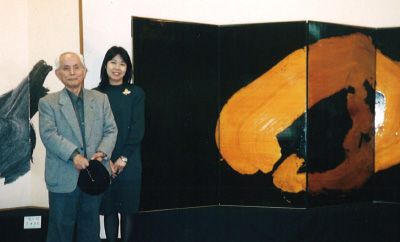Works of Sawako Watanabe, who belongs to Bokujinkai", are available to watch.
Please enjoy BOKUSYO art based on ink and the body.
What is BOKUSYO?
t is an art based on ink in a word. As once called to be avant-garde calligraphy, the name may be more familiar in general. Even though it seems to be similar to action paintings at a glance, BOKUSYO has its own history on how such action and expression has been established. From old times, calligraphy and landscape paintings imported from the continent are well known as works expressed with ink among Japanese. In addition, unrestricted calligraphy works written by monks such as Hakuin and Ryokan were published to the public during Edo period. When calligraphic culture was introduced globally in Meiji period by Tenshin Okakura who established Japanese art, such authors became to appear who turned their eyes to overseas seeking for new place of their activities. They emphasized to focus on form and shape for establishment as an art while remaining traditional calligraphic elements. Then, BOKUSYO, an action to depict meaning of characters as an image, erupted with an artistic quality beyond the direct purpose as ideogram. In 1945, "Den's variation" which is supposed to be the first BOKUSYO was released by Nankoku Hidai as his spirit line work and took the Calligraphy world in storm. With a concept spread among critics that calligraphy should be seen not as character but as lines, the expression has brought new perspective to the whole art world as a new creativity.

Hakuin "Iron rod"
Shinsyouji Temple storage
Photo: Tsuneo Horide

Nankoku Hidai
“Variation of Den"
Chiba City Museum of Art storage
BOKUSYO and ABSTRACT
At the time when Nankoku Hidai tried to depart from a concept "Calligraphy = character" by his spirit line art, Shiryu Morita of Keiseikai led by Sokyu Ueda pursued conversion of the paradigm based on an assumption that "Calligraphy is established as a measure to express characters." Beyond a definition of Calligraphy, it is meaning expression by embodiment like movement of life while being mediated by characters. A phrase "A mind to mark with dots" left by Shiryu. Unexpectedly, it affected foreign people who don't understand Chinese characters. Being affected by BOKUSYO, Franz Kline, an abstract painter in the U.S., deepened exchange with Shiryu. BOKUSYO has been positively introduced overseas. The trend was accepted with impacts in a form of reverse import to western painting in Japan. Subsequently, it is believed that BOKUSYO had impacts on abstract expressionism and Art informel along with appearance of action painting like Jackson Pollock and Gutai art by avant-garde art group. In 1952, Shiryu Morita created Bokujinkai and began a magazine "Bokujin". With detailed its activities before, exchange of letters with Franz Kline is also introduced. Thus, BOKUSYO has been widely accepted by people at large and contributed to energetic activities of Bokujinkai and Sawako Watanabe today beyond generation.

”BOKUBI“ First issue 1952
Title: Yuichi Inoue

With Shiryu Morita "December 1997”


